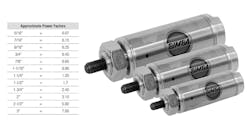Specifying the Right Cylinder for the Right Job
Specifying the right cylinder for the right job results in better and longer cylinder performance. And that means lower overall operating costs.
Proper cylinder size selection begins by calculating 1) the weight of the load, 2) the required velocity, and 3) the air pressure used. Let’s take a closer look at each of these three factors.
Weight of the load:
This is set by the machine design. In order to move the load, you’ll obviously need a cylinder that provides force greater than the load. We recommend allowing an additional factor of 25% force over the load to compensate for friction.
Velocity:
Velocity is also usually set by machine design, but there’s usually some latitude within a range. Low speeds (up to 4 in/sec) require 25% more force than the load, moderate speeds (4 to 16 in/sec) about 50% more and high speeds (greater than 16 in/sec) about twice as much.
Air pressure:
You need consistent airflow at the minimum effective pressure to maintain the desired velocity. Operating the cylinder at too high a pressure accelerates seal wear and creates stress on the cylinder. Inconsistent pressure can cause system malfunction or failure.
Next, you’ll need to determine bore size.
Let’s look at an example assuming a maximum load of 100 lbs, a minimum velocity of 8 in/
sec and a minimum pressure of 60 psi. The velocity is moderate, but the force should be about 50% greater than the load, or 150 lbs.
Dividing the force (150) by the pressure (60) gives you a power factor of 2.5. A 2” bore cylinder, with a power factor of 3.1, provides the needed force.
You’ll also have to consider stroke length, spring force and overall dimensions of the space.
But this is only the start. For more details on proper cylinder sizing and selection, contact Bimba: www.bimba.com
